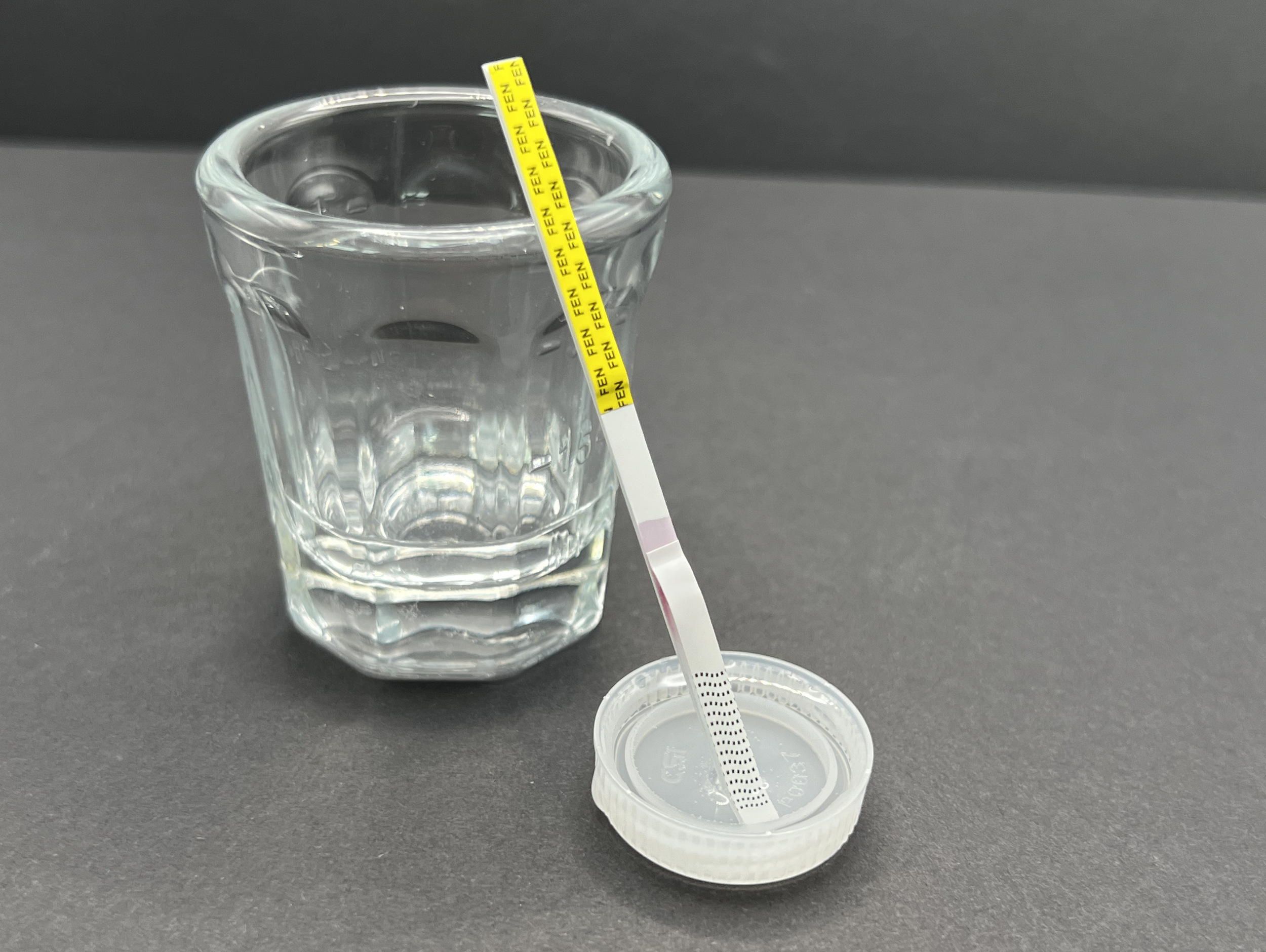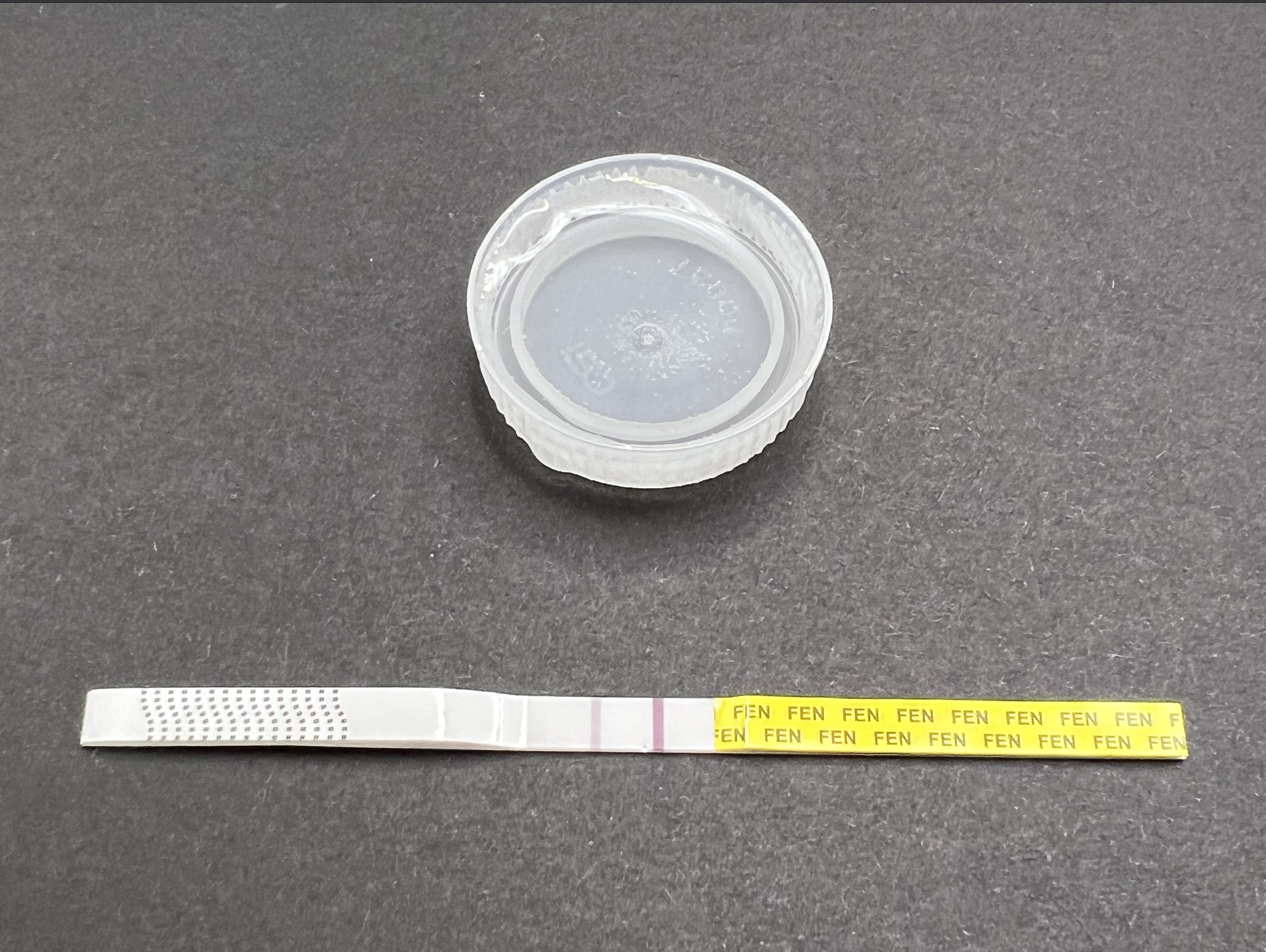Checking your drugs with our Fentanyl Test Strips
Check out the below images for further clarification.
If you are having a problem opening the strip without a pair of scissors, peel the label back to the indents in the strip wrapper.
Step 1 - Dilute. Measure out a teaspoon (5 ml, 1/4 oz) of water. That’s the amount that is held in a 20oz water bottle cap. That’s the same amount that should be used in any container (dixie cup, shot glass, etc.) It doesn’t look like as much in larger containers - but it’s still 5 ml. You can, in fact, use the bottle cap for testing.
Measure 50mg of the product (e.g., a single line of cocaine, or an amount that covers Lincoln’s head on a penny) There are 1000 mg in a single gram - so that’s only 1/20th of a gram for testing). Dissolve that in the 5ml of water.
Step 2 - Test - Place the dotted end of the strip into the water just up to where the dots begin (about 1/4 inch from the end of the strip) for 15 seconds.
Step 3 - Wait - Remove the strip from the water and lay the strip on a horizontal surface and WAIT FOR A FULL 3 MINUTES before reading the results.
Step 4 - Read the Results - If you see 2 lines - even if one is faint - the test did NOT detect fentanyl.
Here is a link to the complete instructions from the manufacturer of our test strips. These instructions also help with non-powder based testing. Unregulated drugs in pill or powder form can be tested (e.g., cocaine, MDMA, ketamine, and other non-injectable drugs) but must be mixed with water prior to testing. Since fake pills may have fentanyl very unevenly mixed into them, the entire pill should be crushed to be sure none is missed. Important: If you test more than 50 mg or product, You must use 5 ml of water for EVERY 50 mg of product you’re testing.



Reducing Your Risk of an Accidental Overdose
There are many substances that can create an increased risk of overdose. While fentanyl is the predominant synthetic opioid causing the majority of the overdoses, these steps are always helpful to reduce your risk as new analogues of fentanyl or other NPS (New Psychoactive Substance) continue to increase. This is even more important if your test indicates positive for fentanyl (only one red line).
The DOPE Project - which is a program of the National Harm Reduction Coalition suggests the following:
Use slow and use less. A little goes a long way with fentanyl and overdoses can occur quickly, sometimes before a person has finished consuming the entire dose.
Try snorting or smoking instead of injecting. Injecting carries the highest risk for overdose, so shifting to snorting or smoking may help reduce risk. A person can still overdose by smoking or snorting, especially with fentanyl, so start slow.
Space out doses. Take time between doses because fentanyl acts fast and is different for everyone, depending on dose and tolerance.
Practice extra caution when using alone. We’re safer together, but it’s not always possible to be with a friend you trust. Try to have someone you know check on you if you have to use alone so they can intervene in the event of an overdose. Consider using the Never Use Alone hotline tel:877-696-1996.
In a group? Stagger your use. Make sure someone is always alert and that at least one person has naloxone (Narcan) on them.
Test it. Knowing what’s in drugs can help with the decision of how much and how best to use them. (Remember - the fentanyl test strips just test for fentanyl and some of its analogues)
Always carry naloxone. Be familiar with the signs of an overdose and be prepared to respond with naloxone (Narcan).
Listen to your body. Overall health impacts overdose risk. Hydrate, eat, and rest as much as possible.
You can find out more by checking out the DOPE Project’s Fentanyl Use and and Overdose Prevention Tips.
Fentanyl in the News and Journals
DEA Issues Public Safety Alert on Sharp Increase in Fake Prescription Pills Containing Fentanyl and Meth September 27, 2021
“Fentanyl Test Strips Empower People And Save Lives—So Why Aren’t They More Widespread?, " Health Affairs Blog, June 2, 2021.
High concentrations of illicit stimulants and cutting agents cause false positives on fentanyl test strips. Harm Reduction Journal, May 2021.
Video: Using Urine Drug Test Strips as a Harm Reduction Tool
Multimedia: FORECAST Study: Detecting Fentanyl. Saving Livings – Johns Hopkins, Bloomberg School of Public Health
Frequently asked questions
Do the strips tell you how much fentanyl is present?
No, the strips only tell you if the concentration of fentanyl or fentanyl analogues is greater than the threshold for giving a positive result. If both red lines are visible (even if the one closest to the end that was in the product), the threshold was not met.
If a fentanyl test strip is negative, does that mean you can’t overdose?
No, even if a fentanyl test strip reveals a negative result could still overdose. There are many risk factors to experiencing an opioid overdose (i.e. mixing drugs, reduced tolerance, using alone, unknown products, physical and mental health, etc.). In addition, fentanyl test strips do have some potential for false negatives and false positives and the drugs being tested may contain a fentanyl analogue that is not detected by the strips. Contact DanceSafe for their latest list of analogues that the strips will detect.


